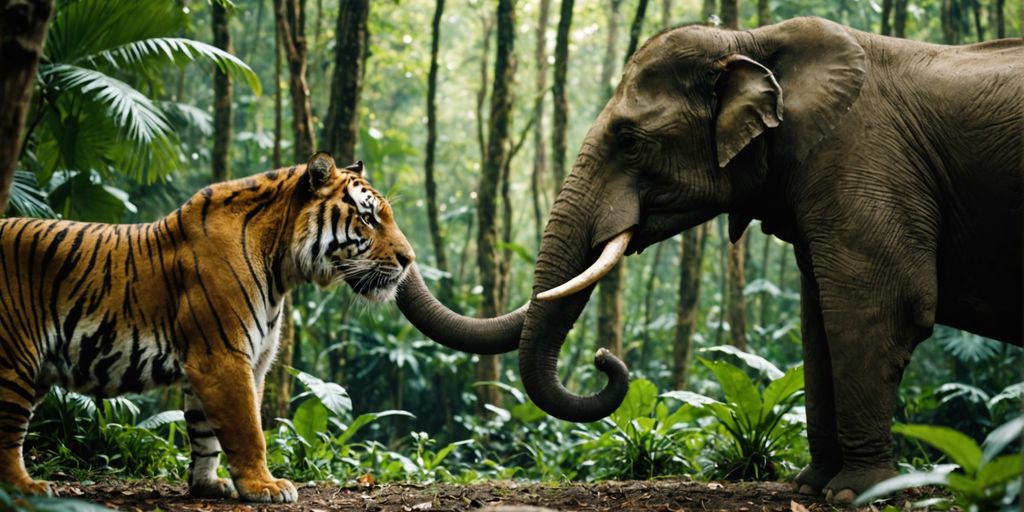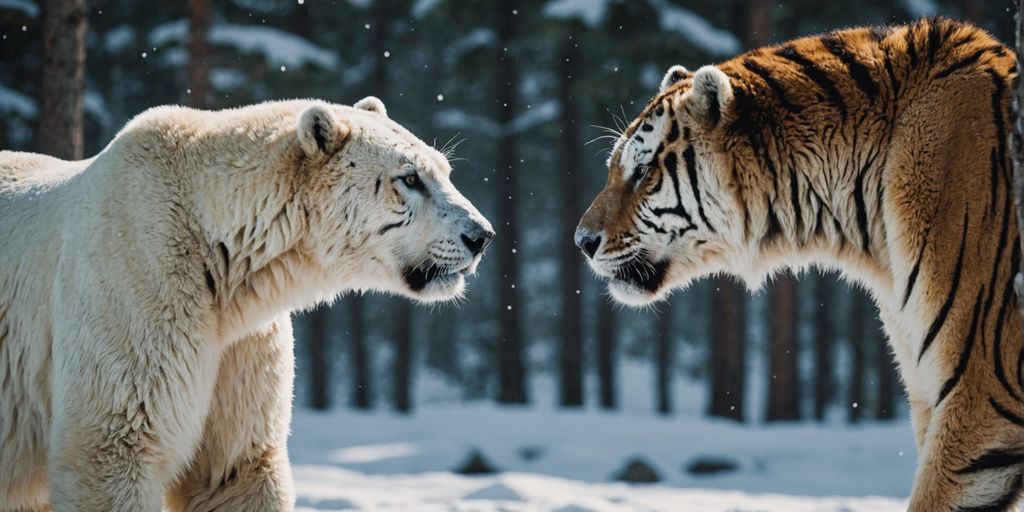Your Cart is Empty
🙏HELP US SAVE TIGERS!🐅 WE DONATE 1% OF OUR SALES TO WILDLIFE ORGANIZATIONS ( WWF ...)
Menu

🙏HELP US SAVE TIGERS!🐅 WE DONATE 1% OF OUR SALES TO WILDLIFE ORGANIZATIONS ( WWF ...)
How Caspian Tiger Disappeared
May 28, 2021 6 min read

Caspian Tiger (Panthera Tigris virgata), also known as the Turanian tiger, Persian tiger, or Hyrcania tiger, is a carnivorous mammal member of the feline family. It has been extinct since the 1970s.
Did you know that he was, according to recent genetic studies, a Siberian tiger? Yes, the apartment belonged to the subspecies of the Siberian tiger. All this opens up possibilities for reintroduction in Central Asia from the genes of the latter. 🐯
We just decided to write this article to introduce you to this incredible big cat and pass on all the unusual information about it. We will explain to you more about why this fawn has disappeared and how we, humans, can save it despite everything.
To understand everything, you can find here :
- All the physical characteristics of the feline
- All the details about its food and its reproduction mode
- The reasons for its disappearance
- The means are currently put in place to try to make him come back.
This great predator was one of the most powerful hunters of the terrestrial world; its concentration and instinct made it formidable. He never took his eyes off his prey, always waiting for the right opportunity to attack. Our Paintings with a tiger, a seasoned hunter, is a perfect illustration of this state of mind. Let's enter without further ado into the heart of the matter. 👇
Characteristics of the Caspian Tiger
Like the other subspecies of striped fawns, the Caspian tiger has its own physical and behavioral characteristics that differentiate it from other furballs.
With a thick fur, large size, and varied habitat, this large mammal is intriguing once roaming between Eastern Europe, the Middle East, and Central Asia. Let's look at all these points in detail.
Physical Characteristics: A Unique Fur
Photographs of Caspian and Amur tiger skins indicate that the main background color of the Persian tiger's fur varied and was generally brighter and more uniform than the Siberian. The stripes were narrower, darker, and tighter than those of other tigers. The color of his lines was a mixture of shades of brown or cinnamon. 🌟
Patterns with the darkest black were invariably found only on the head, neck, middle of the back, and tip of the tail. The contrast between summer and winter coats was marked, but not to the same extent as in the Eastern Russian tigers.

Winter coat was paler, with less distinct of patterns. And summer coat was similar in density and length to the Bengal tiger, although its stripes were generally narrower, lengthier, and tighter. It had the thickest skin among the tigers, probably due to its presence in the temperate regions of Eurasia.
Size and Weight
It was one of the enormous cats that ever existed! The males measured between 270 and 295 cm and weighed 170 to 240 kg. As for the females measured between 240 and 260 cm for a weight of 85 to 135 kg. The length of the skull for males was 297 to 365.8 mm, and 195.7 to 255.5 mm. Its head was much broader than that of the Bengal tiger. 💀
However, some individuals have reached exceptional sizes ranging from 2.25 m to 2.70 m. This was the case of a tiger shot in Azerbaijan in February 1899. Measurements taken after the skinning revealed a body length of 270 cm between the legs, plus a tail of 90 cm long, giving a total length of about 360 cm.

Therefore, the size and shape of the skull of the Caspian tigers far surpassed those of other specimens of tigers from continental Asia and are almost indistinguishable.
The Habitat of the Caspian Tiger
The Caspian tiger was mainly found just south of the Caspian Sea (hence its name). He was commonly found in Iran, Turkey, Iraq, Mongolia, Georgia, Armenia, and even Central Asia. It was thus the only European tiger living partly in Eastern Europe.
It was found in the southern Caucasus, eastern Turkey, northern Iran, and northern Afghanistan in modern times. In 1972, the last traces of the species were found in southeastern Turkey. 🐪
Its preferred environment was a desert environment near water sources, with trees, foliage, shrubs, dense grasses, and reeds called reedbeds.
Moreover, one of the main characteristics that differentiated it from other tigers was that it lived near villages. Despite this, there were few attacks and deaths from him.
Honor the tiger by wearing one of our tiger eye bracelets! 👇
The Tiger of the Romans
Along with the Bengal tiger, the Caspian tiger was the subspecies of tiger (and even wildcat) most used in Roman arenas. For the Romans, this was indeed the easiest way to get felines as they lived throughout the eastern part of the Roman Empire, across the Far East. 🗡️
Tigers were imported from the Caucasus, Kurdistan, Mesopotamia, and Persia. The first tiger to fight in Rome was a gift from an Indian ambassador to the Roman emperor Augustus in 19 BC. In the Roman arenas and the Circus Maximus, tigers fought gladiators, aurochs (a species of bovid now extinct), or Atlas lions.
Reproduction and behavior
Like all other members of its species (all subspecies, in fact), the Caspian tiger spends most of its life alone. Outside of the mating season (winter or spring), there is no way for them to meet a fellow tiger. It is estimated that this animal could live from 10 to 15 years. ❤️
Finally, according to specialists, it is quite possible that these fawns were less sedentary than others, always leaving in search of prey; they probably followed migratory ungulates in their journey from one pasture to another.
Why has the Caspian Tiger disappeared?
The disappearance of the Caspian tiger began with the Russian colonization of Turkestan in the late 19th century, so its extinction is due to several factors;
- The tigers were killed by large groups of sport shooters, military, and other hunters who hunted prey species such as wild pigs.

- The range of wild hogs declined rapidly from the mid-19th century to the 1930s due to over-hunting, natural disasters, and numerous diseases such as swine fever and foot-and-mouth disease, which caused large and rapid die-offs.
- The vast reedbeds where the tiger lived were increasingly converted to cropland for cotton and crops that grew in the rich silt along the rivers.
- These tigers were already vulnerable due to the restricted nature of their distribution; they were confined to the waterways in the large expanses of the desert environment.
Until the beginning of the 20th century, the Russian regular army was used for hunting predators from forests, settlements, and potential agricultural lands. Until the First World War, about 100 tigers were killed annually in the river forests of the Russian territory. Until 1929, high premiums were paid for tiger skins. 😟

In 1972, the last tiger of this subspecies was recorded; it is estimated today that there are no more of these felines in the wild. There are also none left in captivity. Scientists are trying to resurrect the species from the genetics of the Great Siberian Tiger. But at present, it remains among the extinct tigers, along with the Java tiger and the Bali tiger.
Will the Caspian Tiger ever resurface?
With the financial support of the WWF, scientists are trying to resurrect the Caspian tiger since its disappearance in the 1960s to 1970s. Their goal is to recreate a natural habitat in Central Asia and implant this new subspecies genetically similar to the Siberian tigers.

Indeed, scientists have discovered that the Siberian tiger and the Caspian tiger had a common ancestor that populated the whole of Central Asia along the Silk Road 10 000 years ago. They eventually split into two subspecies during an ice age that separated them.
The researchers hope to be able to install 50 tigers within the next 50 years. A very ambitious project which seems feasible given the increase in the number of individuals in Siberia. However, it will also be necessary to reintroduce more animals acting like prey to adapt perfectly. 🐅
Anyway, this project is very close to our hearts! That's why Tiger-Universe is committed to supporting the WWF with 1 USD per order.
If you liked this article and feel concerned by this project, you can help us make this endangered species known and act to preserve tigers by buying one of our tiger plushes by clicking on the image below!
Also in Tiger Blog

Sloth Bear vs Tiger: Who Would Win?
July 13, 2024 7 min read
Explore the thrilling showdown between a sloth bear and a tiger, analyzing their strengths, behaviors, and survival tactics.
Read More
Tiger vs Elephant: Who Reigns Supreme in the Animal Kingdom?
July 13, 2024 7 min read
Explore why elephants usually triumph over tigers in the wild, highlighting their size, strength, and defensive prowess.
Read More
Epic Battle: Polar Bear vs Tiger, who win?
July 11, 2024 8 min read
Epic showdown: Polar Bear vs Tiger. Discover who would win in this thrilling battle of nature's fiercest predators.
Read More

